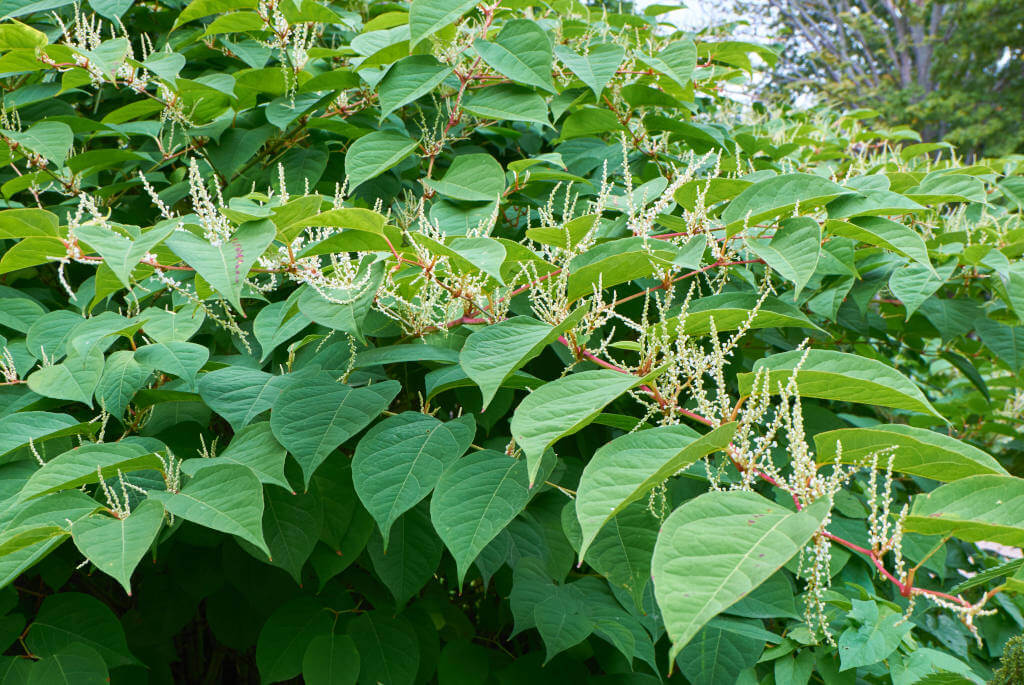
If you are in the process of buying a house, you will no doubt want to be reassured that your purchase is a good investment. Most buyers take a keen interest to find out more about the condition of the building before going through with the transaction, and that’s where our independent property surveys can add real value. But what about the garden?
Were you aware that there may be dangers lurking in the garden that can have potentially serious structural impact on the building? If you haven’t heard of Japanese knotweed, now is the time to sit up and take notice. It could be bad news.
What is Japanese knotweed?
Japanese knotweed (Fallopia japonica) may look like a regular perennial weed but it is a highly invasive species that thrives pretty much anywhere and is virtually indestructible. It originates in Japan and was introduced to the UK in the mid-1800s as an ornamental garden plant. Unfortunately, unlike in its native habitat, knotweed has no natural enemy in this country.
Plants grow rapidly through the warmer months – up to 10cm per day – and die back in the wintertime, only to return with renewed vigour the following year. The speed of growth can cause problems with biodiversity, flood management and damage to property. Mature specimen are powerful enough to undermine man-made structures, able to push up through patios, tarmac and concrete, and through drains and cavity walls.
How do you spot it?
At Able Surveyors, our Chartered Surveyors know to look out for Japanese knotweed in gardens and outdoor spaces. Its pale green shield-shaped leaves on tall, hollow stems bear a resemblance to bamboo and can grow up to 3 metres high. When in bloom, there are clusters of small white flowers in upright formations.
While Japanese knotweed can be found in most places in the UK and will grow happily in any terrain and on any soil, it is perhaps Victorian properties that are most at risk. Houses built in the mid to late 19th century are most likely to be suffering from historic problems with this plant. UK maps and online plant trackers are also available to help you identify areas where knotweed may be a local problem.
In actual fact, finding Japanese knotweed in the garden shouldn’t come as surprise. There is a specific question on The Law Society’s TA6 Form which forms part of pre-contractual enquiries that the seller must answer. A false declaration means you could sue the seller under the Misrepresentation Act.
Why is Japanese knotweed a serious problem?
As you may have already gleaned from the information provided thus far, the presence of knotweed on the grounds (or anywhere in the vicinity) of a property you are thinking of buying constitutes a real risk that goes beyond the nuisance factor of having to deal with fast-growing shrubbery in the garden.
Knotweed can spread with great speed and resilience, damaging building structures in the process and exploiting any weak points that may already be present. From underground drains to paving, tarmac and retaining walls, even causing subsidence issues to the main foundations of the house, this plant takes no prisoners.
Will knotweed affect the property value?
Indeed, it shouldn’t come as surprise to hear that mortgage companies take a very dim view indeed when it comes to lending on knotweed-afflicted properties. Many won’t approve a loan on properties that show evidence of knotweed within 7 metres of the boundary. Of those who do, they will insist on a Knotweed Management Plan (KMP) being in place, which is a prerequisite for house buying and selling of knotweed-affected properties. According to Environment Agency regulations, once you find Japanese knotweed on a property, it is essential that you set up some form of KMP.
Needless to say, knotweed majorly affects the saleability of the property and impacts its value, both for your upcoming transaction and future sales. According to official figures, untreated knotweed infestations can reduce property value by 10%. What’s more, even if the plant has been treated and removed, the drop in value can still be as much as 6-9%.
If your Building Survey has flagged up Japanese knotweed, you must speak to the seller and their agent and at the very least review the previously agreed price.
How can you get rid of it?
Controlling Japanese knotweed is a difficult and expensive task that requires specialist contractors. Very few knotweed specialists currently offer a 100% removal guarantee. Where Japanese knotweed is considered to pose a risk to the property, it is usually necessary to agree to eradicate the plant by implementing a long-term Knotweed Management Plan to satisfy the requirements of the lender.
The removal of knotweed is generally carried out in 3 steps:
- Excavation – digging out all plants and the surrounding contaminated soil, and disposing of it as ‘controlled waste’ by licensed carriers to licensed landfill sites. It’s a laborious and costly exercise.
- Herbicide control – repeated application of herbicide to kill the plant gradually, including stem injections. It can take months and years to gain control.
- Physical barriers – inserted along the boundary to arrest and contain the spread of knotweed to another property.
What are your options as a buyer?
As a potential buyer, you may well decide not to proceed with the purchase and steer clear of any property affected by this invasive plant. However, the presence of knotweed need not be a dealbreaker as long as you go into the purchase with your eyes wide open and with a clear plan of action.
At Able Surveyors, we can help with a wide range of range of surveying services and Specific Defect Reports for properties across London and Essex. Contact the team to discuss any Japanese knotweed issues at the property you are thinking of buying and let us help you understand the potential implications and ramifications, so that you can make the best decision.
